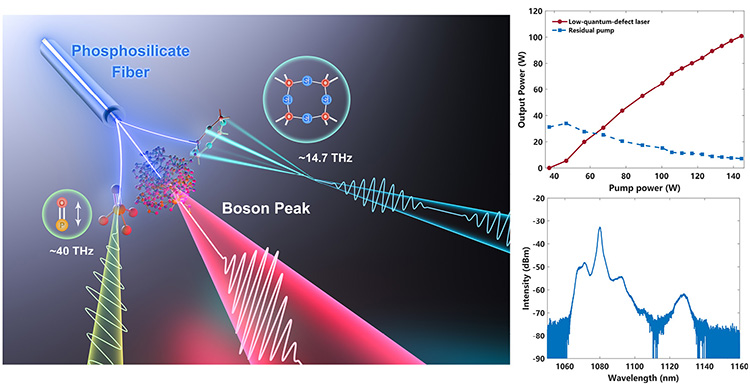 Low-quantum-defect fiber laser. Left: Operating principle; top right: output power evolution as a function of pump power; bottom right: spectral characteristic of output laser at maximum operating power.
Low-quantum-defect fiber laser. Left: Operating principle; top right: output power evolution as a function of pump power; bottom right: spectral characteristic of output laser at maximum operating power.
High-power fiber lasers are widely employed in scientific and industrial applications for their compact structure, high conversion efficiency and robust operation.1 However, waste-heat accumulation in the gain process of these lasers can challenge performance in beam quality, frequency and amplitude noise and other areas. One of the main sources of heat generation is quantum defect, which describes the photon’s energy loss in the laser gain process. In work this year, we proposed a high-power, low-quantum-defect fiber laser solution.
The value of quantum defect—defined as η = 1 − hνs/hνp, where h is Planck’s constant and νs and νp are the lasing and pumping frequency—is crucial for exploring materials and setups for high-power laser performance. One example from several years ago was the demonstration of 400-mW-level laser, which employed multicomponent fluorosilicate fiber with a QD of 0.92% and a maximal slope efficiency of 62.1%.2
Furthermore, previous studies have found a plentiful Raman gain spectrum inphosphosilicate fiber.3 In addition to the Raman gain peak associated with the vibration of silicon–oxygen chemical bonds at a frequency shift of about 14.7 THz, there is also a phosphorus-related Raman gain peak at a frequency shift of about 40 THz, and a boson peak with little frequency shift. However, few previous works have investigated the potential application of this boson peak for laser generation.4
Our recent work takes advantage of the boson peak in phosphosilicate fiber to enable a low-quantum-defect fiber laser.5 The laser cavity consists simply of a pair of fiber Bragg gratings centered at 1080 nm, with a section of phosphosilicate fiber in between. We thoroughly investigated the effect of phosphosilicate fiber length, pump bandwidth and feedback reflectivity on the output characteristics to ensure high-power, high-efficiency lasing. With the optimized system parameters, the low-quantum-defect fiber laser achieved a 100.9-W maximum output power, with quantum defect reduced to 0.97%. The corresponding slope efficiency was 94% and the spectral purity was 91%.
To our knowledge, this is the first demonstration of a low-quantum-defect, hundred-watt-scale phosphosilicate laser enabled by the material’s boson peak, and the power represents a record for a laser with so low a quantum-defect value. We believe that the work could provide solutions for thermal management, improvements in reliability, efficiency and power scaling, and noise suppression for fiber lasers, and may find application in a variety of fields.
Researchers
Xiaoya Ma, Jun Ye, Yang Zhang, Jiangming Xu, Liangjin Huang, Tianfu Yao, Jinyong Leng, Zhiyong Pan and Pu Zhou, National University of Defense Technology, Changsha, China
References
1. C. Jauregui et al. Nat. Photon. 7, 861 (2013).
2. N. Yu et al. Opt. Lett. 43, 3096 (2018).
3. G. Salceda-Delgado et al. Opt. Quant. Electron. 44, 657 (2012).
4. Y. Zhang et al. Photon. Res. 8, 1155 (2020).
5. X. Ma et al. Opt. Lett. 46, 2662 (2021).
